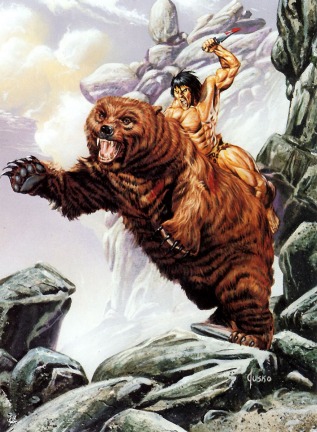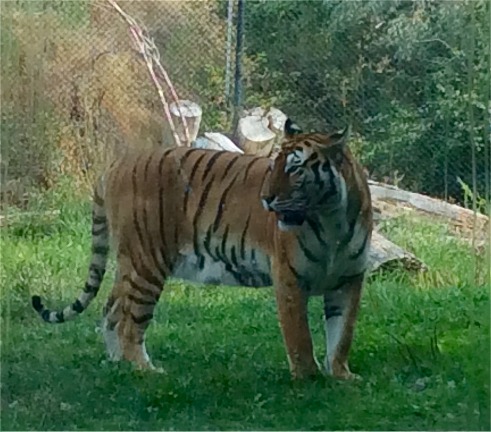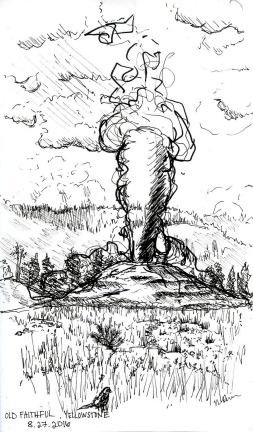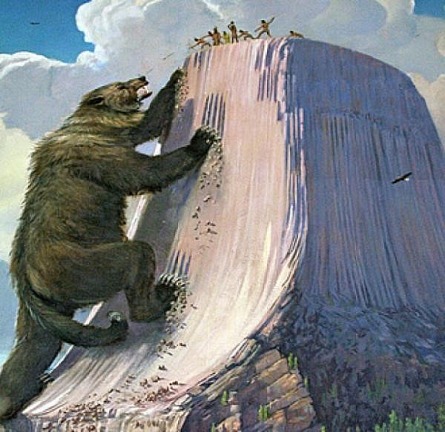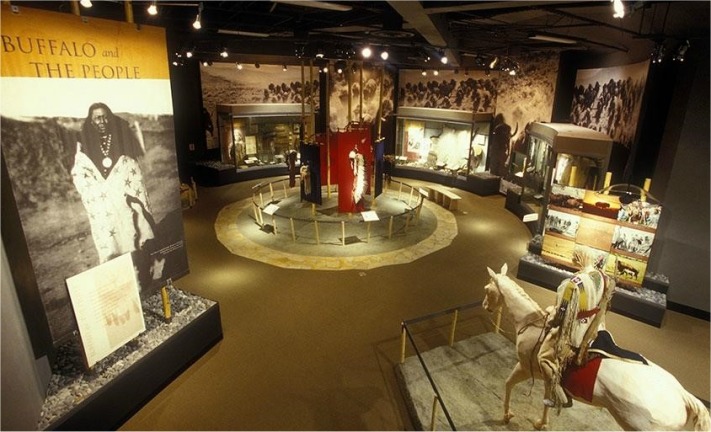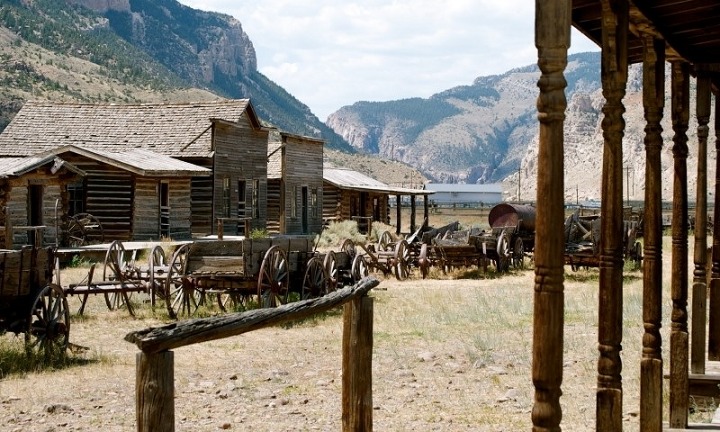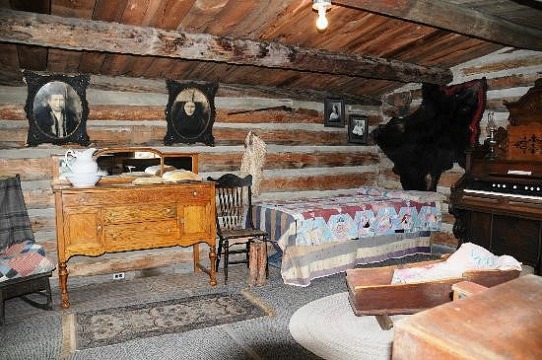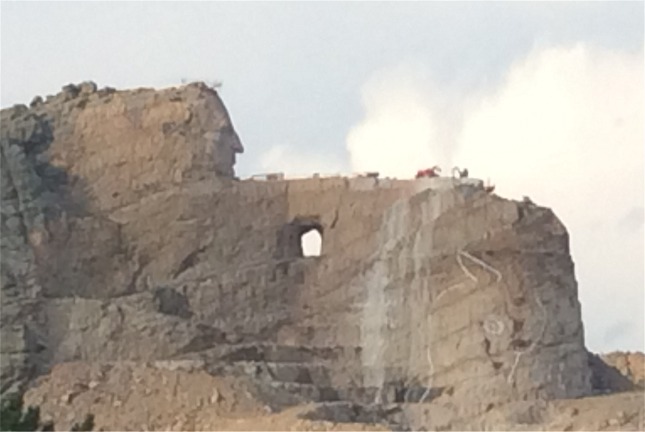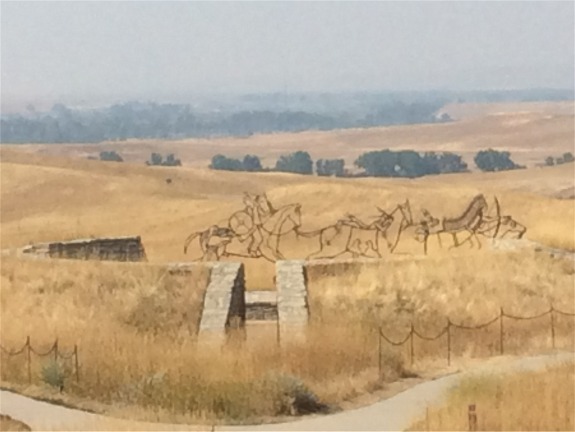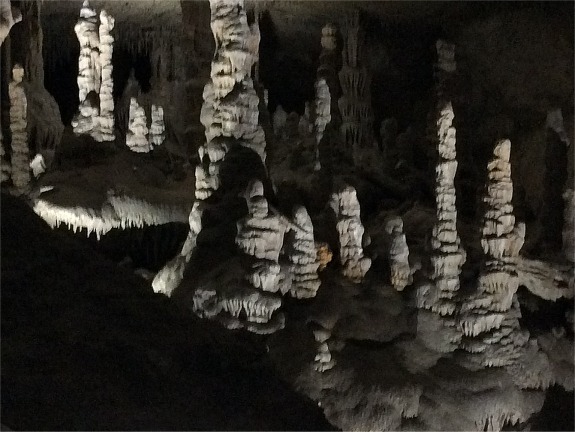4: Realm of the Cave Bear
Besides
the variation in weight, what is the difference between a 300-pound grizzly
bear and an 800-pound grizzly bear?
Not much. Not much at all.
Bella and Brutus were two of the five bears who
live at Montana Grizzly Encounter, about 11 miles east of Bozeman,
Montana. Bella, said the keeper, weighed in at 300 while Brutus, her friend,
was an 800-pounder. But to look at them one might have guessed a differential
of 200 pounds, not 500. The point is, a mature grizzly bear looks like
it's about 800 pounds, whether it actually is or not. And a 300-pounder
could just as easily rend a human victim from limb to limb as its bigger
counterpart.
Bella and Brutus were out in the large "yard" at
Grizzly Encounter when we arrived. We didn't see the other three bears,
or even Goldilocks for that matter, since they were secured in their "den,"
as the bears are grouped with whichever other bears they get along with.
Otherwise, bear fights can break out and while they might be entertaining
for spectators they are not healthy for the bears themselves.
After Bella and Brutus have been out in the open
air long enough, their den door is opened and they go back in when they're
ready, lured by food and the opportunity to do one of the things bears
enjoy -- sleep. There is no one who goes out with a whip and a chair to
encourage the bears to go inside. They go when they're ready, and not until.
Then, and only then, are the other bears allowed to come out.
These two bears, along with the bears at Zoo Montana
in Billings and the ones at the Grizzly and Wolf Discovery Center in the
town of West Yellowstone, are reminiscent of the prehistoric cave bear
bested by Tarzan in Tarzan
at the Earth's Core.
The Canaveral edition of that book is an important
part of one's collection. Henry Hardy Heins, author of A Golden Anniversary
Bibliography of Edgar Rice Burroughs, points out that the Frank
Frazetta illustration opposite page 158 of the Canaveral shows one stage
of Tarzan's battle with the cave bear on the cliff ledge, while his color
cover for the Ace paperback, published a couple of months later, shows
the final stage. (Heins, pg. 72)
The battle was one which took all of Tarzan's skill
and used every one of his weapons and was helped along by a little bit
of luck.
First, Tarzan shot four arrows into the beast,
then hurled his spear at it. The apeman then ran down the ledge, the wounded
bear in pursuit. He used his grass rope to snag its lasso on a projection
above and started climbing. (Then, the chapter ends and the reader has
to wait until the end of Chapter
XI The Cavern of Clovi, for the finish of the fight.) As chapter
XI begins, the rope broke, dumping Tarzan onto the bear's back, where he
was able to finish it off with his knife.
No exact poundage is given for Tarzan's bear, probably
because Abner Perry had not yet invented a scale big enough to weigh it,
nor was Perry handy at this particular time to even pull out his homemade
tape measure, but the bear is described as "huge," "giant" and "mighty."
ERB wrote: "Tarzan's first impression was that
in all his life he had never gazed upon such a picture of savage bestial
rage as was depicted upon the snarling countenance of the mighty cave bear
as its fiery eyes fell upon the author of its hurt."
Internet sources describe the weight of an average
prehistoric cave bear as between 770 to 1,320 pounds, with exceptional
ones achieving as many as 800 pounds. So the beast Tarzan faced was at
least the size of Brutus and perhaps several hundred pounds more.
The bears incarcerated in various facilities in
Montana are not simply captured to become freak shows but usually
have somewhat of a history that makes it impractical for them to be released
into the wild. The only alternative other than a life in a compound is
euthanasia.
The people in Montana seem to love their bears,
though, and take good care of the ones who have to be placed where they
cannot hurt anyone.
Coram, one of the bears at Grizzly and Wolf Discovery
Center, West Yellowstone, had begun making a habit of visiting people's
homes to eat everything from dog food to garbage. Efforts to return him
to the wild -- far, far from civilization -- proved unsuccessful. Like
the cat who came back, Coram found his way cross-country back to where
people live.
The Discovery Center also employs its bears in
a useful activity designed to help other bears. The Center constantly experiments
by placing a "food reward" inside a "secure" container, such as a special
ice chest or garbage can, and leaving it in the bear arena. These containers
are provided to the Center by manufacturers who try to develop bear-proof
food and garbage containers.
When the bears are released, they can smell the
treat inside (fresh fruit, fish, or similar reward) and they attempt to
open the container with claws, their teeth, their weight or any combination
of those things. Many times, the bears are successful. But sometimes they
are unable to open a container, and the Discovery Center then is able to
inform the manufactuer that it has found a way that homeowners can secure
garbage or other edibles outside that will discourage bears from thinking
of homes as a place for free food.
On the day we visited, one of the bears worked
for about 30 minutes on a well-protected cooler and never did get it open
while we were there. After we left, who knows?
In the stone age world of Pellucidar, food is probably
highly valued because it is difficult to come by and so the Pellucidarians
are not likely to have many leftovers to toss in the trash and, thus, camp
followers, whether cave bears or smaller fry, are less likely to seek such
settlements out for their trash, although they might indeed wish to haunt
them for fresh human meat.
5: Riding with the 7th
Cavalry
Buffalo
Bill Cody, Wild Bill Hickok, George Armstrong Custer and Edgar Rice
Burroughs were all linked in one way or another with the U.S.
7th Cavalry. The first three were contemporaries and acquaintances
or friends as well. Cody and Custer both served in the 7th Cavalry. Hickok
served Custer as a scout during Indian wars and later related to the 7th
Cavalry in a different way when he wounded one Cavalryman and fatally shot
another in self-defense in a bar fight.
That was in the decade of the 1860s up into the
1870s.
A few years later, in 1896, Edgar Rice Burroughs
came along and served with the 7th further south, at Ft.
Grant, Arizona, for a couple of years, chasing Apaches.
Custer and Hickok were both featured in television
series, Guy Madison playing the marshal in “The Adventures of Wild Bill
Hickok from 1951 to 1958 and Wayne Maunder playing “Custer” for 17 episodes
in a short-lived series that ran in the fall of 1967. The historic Buffalo
Bill never got a TV series, although there was “Buffalo Bill Jr.,” no relation
to the buffalo killer but named for him, in a 1955-56 series starring Dick
Jones. There was also a 1983-84 series called “Buffalo Bill” but it was
about a modern-day egotistical talk show host played by Dabney Coleman,
as opposed to an egotistical westerner once played by Paul Newman in a
movie.
Edgar Rice Burroughs never had a TV series about
his life, but he certainly had shows about his most famous character, Tarzan
of the Apes, as well as radio
shows and movies. Wolf
Larson, Ron Ely, Joe Lara and Travis Fimmel have all donned the loin cloth
for Tarzan TV series of varying quality, and Gordon Scott shot three episodes
of a proposed series that was combined for a movie instead.
ERB's cavalry career was undistinguished and he
spent a lot of his time in ill health, but it served as a resume enhancer
for the man who would eventually become one of the most pubished authors
in the world.
Burroughs was undoubtedly aware of his outfit's
defeat a quarter of a century earlier at Little Bighorn. His familiarty
with the name of Custer may or may not have been from where he plucked
the names of Barney and Victoria Custer as protagonists in two of his books,
The
Mad King and The
Eternal Lover.
We enjoyed our time of exploring both of these
sites which are somewhat loosely related to ERB himself. The Little Bighorn
Battlefield is in Crow country and the Native Americans continue to celebrate
their victory with the presence of a large souvenir-shop and eatery next
to the battlefield. In addition to sections commemorating the fallen cavalrymen,
the area also features memorials to the Indians who fought there, some
dying, for their own way of life.
A visitor will find a museum and national cemetery
at the bottom of the hill upon which Custer had his last stand. The 25-minute
video presentation in the museum is good to watch before exploring the
battlefield, as it puts all in context. There is also a live ranger talk
on the shaded museum porch beneath Last Stand Hill but it covers the same
history as the video and the video does it better.
One-hundred fifty miles south and west of the Little
Bighorn Battlefield, near Hardin, Montana, lies the town of Cody, Wyoming,
named for Buffalo Bill himself and a gateway to the eastern entrance to
Yellowstone National Park.
This was a footloose and fancy free trip, with
decisions made day by day. Our original plan didn't include a visit to
Cody, as we planned to enter Yellowstone from the south. However, advertising
signs along I-90 persuaded us that Highway 16 was the "most scenic" and
"safest" route, and it was, especially through the Bighorn mountains and
National Forest. But it was also the most boring stretch of road from Worland,
Wyoming, to Cody. But it was worth it. Once in Cody in late afternoon,
and seeing the attractions available, we lined up our motel for two nights
instead of one so we could spend a day looking at everything, and even
then a day was not long enough.
Cody has a western flavor to it, including an attraction
called Old Trail Town, which is a couple of city blocks of authentic pioneer
buildings, most of them disassembled elsewhere and moved to this location,
including the cabin used by Butch Cassidy and the Sundance Kid in their
secret hideout in Hole-in-the-Wall of the Bighorn Mountains in Johnson
County, Wyoming.
Not only have some buildings been relocated, but
some bodies have been dug up and reburied there as well. The Old Trail
Town cemetery has seven graves, all with markers far more ornate than the
original ones probably were. I hadn't heard of most of the people although
they all achieved their own degree of fame or infamy in the west. The main
grave was that of Jeremiah Johnston, also known as Liver-Eating Johnston
because of stories that he killed 300 Crow Indians over a period of time
and ate their livers as revenge for them killing his wife. The Crows believed
a man had to have his liver in order to make it to the afterlife.
But the big attraction in Cody, as far as we were
concerned, was the Buffalo Bill Center of the West. One big plus was that
it was air-conditioned, whereas Old Trail Town was definitely realistic
in that it baked in the hot sun. However, the Buffalo Bill Center is a
premiere attraction, with outstanding exhibits on Buffalo Bill's life,
and a section with multiple weapons used by the armed forces, old west
personalities and TV cowboys. It also included large sections on Native
American life as well as the wild animals of the region.
6: The Thunder of Old
Faithful
"The first intimation of it was a sudden lightening
of the sky...." Water "commenced to boil...Vast clouds of steam arose....
Enormous clouds of steam blotted out everything.... They rose to the clouds,
dimming the sunlight. ....Clouds of condensing vapor whirled and swirled....
there was nothing to see but billowing clouds of vapor."
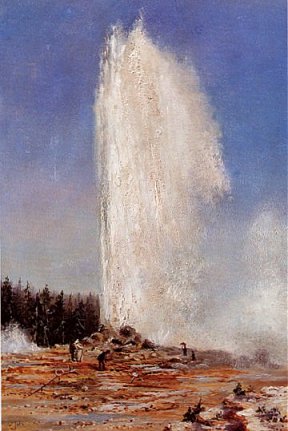
Old Faithful by J. Allen St. John
(In the 1920s J. Allen St. John illustrated stories for many
of the top magazines, such as Colliers, The Rotarian, and Liberty. He also
painted covers for The Green Book, The Red Book and Blue Book. That
could well be applied to Yellowstone's most famous geyser, Old Faithful.)
But it was written by Edgar Rice Burroughs in chapters
1 and 2 of Escape
on Venus, describing a storm that Carson and Duare survived
while their airplane was buffeted about by a sudden, fierce storm over
Amtor.
Old Faithful is probably the most-photographed
natural phenomenom in the world, most likely because it shoots steam into
the air from 21 to 23 times a day.
There are huge parking lots to accommodate all
of the vehicles of park visitors. Depending upon how large your local Walmart
is, put five or six of their parking lots side by side and you get an idea
of how large the parking area is, and even then I might be underestimating
it.
I know something of the size of it because both
times I have been there I have dropped my companions off as close as I
can get them to the geyser and then looked for a parking place and walked
back. This time the far end of the furthest lot was where I found a place
to park and the walk back was a good 15 minutes. Fortunately, unlike the
first time I did that several years ago, I was in plenty of time to see
the next eruption. The geyser itself, which has its opening atop a wide,
low mound of volcanic earth, lets out steam most of the time but shoots
super-heated water anywhere from 100 to 180 feet into the air with each
eruption.
Spectators take advantage of a boardwalk built
a respectful distance from the actual opening, where they are not only
safer but also can get a good view for taking pictures of the whole eruption.
In all, the area surrounding the geyser vent and the boardwalk is, itself,
the size of a couple of those big parking lots.
When I got back, I couldn't see Dan or Schuyler
in the crowd, so I sat down on a small log which was in the middle of an
open area between the boardwalk and the souvenir shop. The sky this day
was a bit gray, so photos would probably not be as good as ones that would
show the steaming eruption against a clear blue sky, but I took several
anyway.
As it became obvious that the eruption was about
to take place, thunder sounded from nearby. I couldn't hear him, but my
son later told me that a ranger was walking along the boardwalk recommending
to people that they seek shelter from the approaching lightning and rain.
But virtually everyone ignored him. Not only were they there to see Old
Faithful, but this was a unique opportunity to experience it with the accompaniment
of lightning flashes and rumbling thunder.
I’m not aware if Edgar Rice Burroughs every visited
the Yellowstone geysers, although he certainly loved to travel and camp
in many places of America. It would have been interesting to see how he
would have written up a description of an eruption, but the closest I think
he comes is parts of his description of the storm on Venus although that
involved other dangers not present in Yellowstone National Park the day
we were there, Aug. 30, 2017.
Burroughs wrote in an imaginatively descriptive
way of the flora and fauna of the worlds populated by his characters and
sometimes wrote of the weather as well, especially when it served as a
vehicle for moving his characters from one plot situation to another, as
was the case for the storm which launched the couple on Amtor into a series
of captures and escapes.
And who did not fear for the safety of Tara of
Helium when her small Martian flyer was carried by a stubborn storm to
a world of exotic adventure in ERB’s The
Chessmen of Mars?
ERB wrote: "The air was filled with dust and flying
bits of vegetation and when the storm carried her across an irrigated area
of farm land she saw great trees and stone walls and buildings lifted high
in the air and scattered broadcast over the devastated country; and then
she was carried swiftly on to other sights that forced in upon her consciousness
a rapidly growing conviction that after all Tara of Helium was a very small
and insignificant and helpless person." (Chapter
II, "At the Gale's Mecy.")
And perhaps ERB came up with no better description
of a thunderstorm than that found in "The
End of Bukawai," Chapter VII of Jungle
Tales of Tarzan.
It went this way:
"And all over lay a sickly, pallid ocher light
through which the scourged clouds raced....
"Now he heard a low moaning, far away. 'The
lions seek their prey,' he murmured to himself, looking up once again at
the swift-flying clouds. The moaning rose to a great volume of sound. 'They
come!' said Tarzan of the Apes, and sought the shelter of a thickly foliaged
tree. Quite suddenly the trees bent their tops simultaneously as though
God had stretched a hand from the heavens and pressed His flat palm down
upon the world. 'They pass!' whispered Tarzan. 'The lions pass.' Then came
a vivid flash of lightning, followed by deafening thunder. 'The lions have
sprung,' cried Tarzan, 'and now they roar above the bodies of their kills.'
"
Then.... "...the rain came -- not as
it comes upon us of the northlands, but in a sudden, choking, blinding
deluge. 'The blood of the kill,' thought Tarzan."
7: From Mountains to the
Earth’s Core
The expedition in the Sub-Mole-Rine included ancient
rock carvings and formations, mostly in the region where Wyoming and South
Dakota meet. One, on the side of a mountain named Rushmore, south of Rapid
City, features four human faces, only one of which is depicted with the
upper half of a period costume, wide lapels and all. Further south of these
is the face of a Native American named Crazy Horse protruding from the
top of another mountain, with related sculpture work going on below his
mug. Crazy Horse became famous for helping to kill off a bunch of ERB's
predecessors in the 7th Cavalry at Little Big Horn, about 300 miles northwest
of where the war chief's image is being sculpted with dynamite and chisel
from a mountain.
These were both reminiscent of the Great
Tur in The Master
Mind of Mars, at least as far as the size of the heads was
concerned. The carvings on both mountains were said to have been in unfinished
states. The Great Tur, however, was finished, in more ways than one.
Next door, in the state of Wyoming, stands what
is said to be a large formation of volcanic material which pushes up from
beneath the Earth. It is known by the locals as Devils Tower and, sadly,
it is not a real geologic feature but just a large movie prop that was
never properly dismantled after playing a key role in 1977's "Close Encounters
of the Third Kind."
No doubt the 800-foot tall attraction was left
standing to aid the local economy, which specializes in selling postcards
of the image, small paperweight reproductions, and various alien souvenirs.
In addition to the belief of some that it was formed
by igneous intrusion, the other popular "origin story" is that was a rescue
by the Great Spirit of five little Indian girls (or a couple of boys, depending
on which story you hear) who were trying to escape from a giant bear. In
answer to their prayer, the landscape arose to a height of 867 feet from
its base and the vertical striations in the rock are from the claws of
the big bear who tried, unsuccessfully, to scale its heights.
Local images of the bear reveal it has a tail to
match the tale:
Devils Tower is actually made of a specially engineered,
durable rubber and is kept inflated with the exhaust from automobiles of
tourists who drive their cars up the winding road from the Belle Fourche
River basin to the base of the tower. The exhaust is sucked off by vaccuum
tubes cleverly designed to blend in with the roadside verdure, and piped
to the base of the tower itself.
Nonetheless, it is a spectacular attraction through
not specifically related to ERB as one cannot claim with any degree of
accuracy that it was his inspiration for the nom de plume of the Apache
Devil, as applied to Shoz-Dijiji, protagonist of The
War Chief and its sequel.
It was from this area that we ventured on
to Cody and Yellowstone and, after that, northward back to Montana and
an entrance to Pellucidar.
The Lewis and Clark Caverns, just south of Butte,
Montana, are not advertised as an entrance to the inner world but what
other purpose could these caves, and others like them, serve, if not as
gateways to Pellucidar, if one knows how to negotiate them?
Shenandoah Caverns, Virginia, is apparently another
entrance to Pellucidar and was explored, under the direction of David Critchfield
Von Horst, during the 2010 Edgar Rice Burroughs Chain of Friendship gathering.
Access to Lewis and Clark Caverns is at the top
of a winding road and consists of a parking lot, a gift shop, an eatery,
restrooms and the interpretive center at which one purchases tickets for
the cavern tour. I bought one for each of us, and listened to the last
part of the pre-trip lecture which had already started before we arrived.
"Let's go spelunking," said the tour director,
and everyone turned, not toward a doorway that led to a set of steps going
down, but to a trail which ascended further up the mountain. In fact, its
route could clearly be seen as ascending about a mile up the side of a
mountain and who would know how much further it would go after it, like
the bear, went over the other side of the mountain? I took about 10 steps
before making the type of wise decision for which I am known and which
qualifies me as the master of the Sub-Mole-Rine. I said to my son and grandson,
"I don't think I can make it. I'll wait here."
Yes, the best chance I would ever have to to find
an entrance to Pellucidar, and I turned it down, primarily due to a heart
condition. The ticket seller said they would be gone a couple of hours
but it turned out to be about 45 minutes longer than that because they
had the slowest of the guides, I found out later. My son, upon his return,
said the guide had a pet name for about every rock that they found in the
cave.
As for me, I went to the souvenir shop and examined
colorful postcard images of the cave's many rooms, and then retired to
the eatery and ordered, and then slowly ate, a chili dog, while catching
up entries in my captain's log.
Alas, when my son and grandson returned they had
seen not a clue of an entrance to Pellucidar. But, they are not ERB fans
to the depth that I am, so they probably just didn't know how to look.
That night we slept soundly in a Super 8 motel
in Butte and rose at 6 a.m. to hit the road for home, back across the Idaho
panhandle and through Eastern Washington. I had planned to turn south at
Ellensburg and cross the volcano-riddled Cascade Mountains over the White
Pass Highway (U.S. 12) but got engaged in a conversation with my son and
we missed the turnoff. So, I decided I’d just stay on I-90 and cross the
mountains at Snoqualmie Pass, then turn down the Highway of Death (U.S.
18) to get to I-5.
This proved to be the harriest part of the
trip, not because of the Highway of Death but because it was Thursday,
Aug. 31, and many were on the roads, getting an early start on the Labor
Day Weekend. But, with true grit, I expertly weaved through the freeway
traffic and lost little time, despite the clogged roads.
Home, at last. Time to relax with an Edgar Rice
Burroughs book!


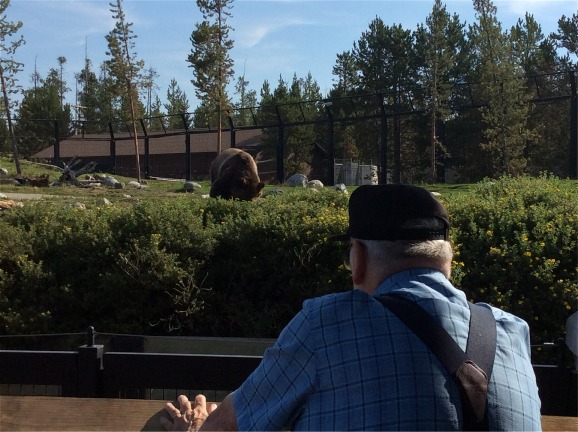 .
.